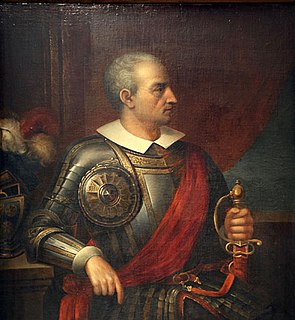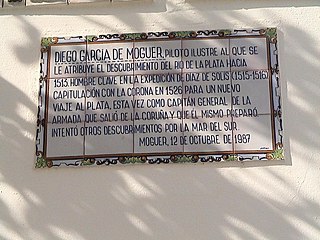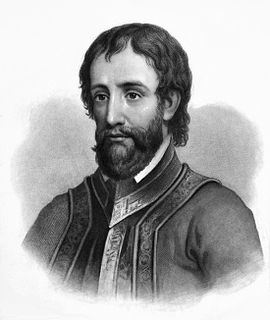 W
WDiego de Almagro, also known as El Adelantado and El Viejo, was a Spanish conquistador known for his exploits in western South America. He participated with Francisco Pizarro in the Spanish conquest of Peru. While subduing the Inca Empire he laid the foundation for Quito and Trujillo as Spanish cities in present-day Ecuador and Peru respectively. From Peru Almagro led the first Spanish military expedition to central Chile. Back in Peru, a longstanding conflict with Pizarro over the control of the former Inca capital of Cuzco erupted into a civil war between the two bands of conquistadores. In the battle of Las Salinas in 1538 Almagro was defeated by the Pizarro brothers and months later he was executed.
 W
WJosé de Bustamante y Guerra, sometimes referred to simply as Bustamante, was a Spanish naval officer, explorer, and politician.
 W
WDiego Caballero was a Spanish merchant and minor Conquistador in the Caribbean area and in the islands off the coast of Venezuela. He organised raids on natives, whom he then used as slaves in pearl fishing and other enterprises. He amassed enormous wealth in America, which he invested in further enterprises throughout the Spanish Empire. He thus became enormously wealthy, perhaps the most important Spanish merchant of his day. He held, or purchased, several official posts, in the service of the King, Charles V and in Seville.
 W
WPedro Sarmiento de Gamboa (1532–1592) was a Spanish explorer, author, historian, mathematician, astronomer. His birthplace is not certain and may have been Pontevedra, in Galicia, where his paternal family originated, or Alcalá de Henares in Castile, where he later is known to have studied. His father Bartolomé Sarmiento was born in Pontevedra and his mother María Gamboa was born in Bilbao, Basque Country.
 W
WThe García de Nodal expedition was chartered in 1619 by King Philip III of Spain to reconnoiter the passage between the Atlantic and Pacific oceans, rounding Cape Horn, south of Tierra del Fuego, just discovered by the Dutch merchants Jacob Le Maire and Willem Schouten. It was a successful expedition, as all goals were reached. In addition, neither lives nor ships were lost and the whole was done in a small amount of time.
 W
WDiego García de Moguer was a Spanish explorer who also sailed for the Portuguese Crown later in life.
 W
WÁlvar Núñez Cabeza de Vaca was a Spanish explorer of the New World, and one of four survivors of the 1527 Narváez expedition. During eight years of traveling across what is now the US Southwest, he became a trader and faith healer to various Native American tribes before reconnecting with Spanish civilization in Mexico in 1536. After returning to Spain in 1537, he wrote an account, first published in 1542 as La relación y comentarios, which in later editions was retitled Naufragios y comentarios. Cabeza de Vaca is sometimes considered a proto-anthropologist for his detailed accounts of the many tribes of Native Americans that he encountered.
 W
WAlonso de Ojeda was a Spanish explorer, governor and conquistador. He travelled through Guyana, Venezuela, Trinidad, Tobago, Curaçao, Aruba and Colombia. He navigated with Amerigo Vespucci who is famous for having named Venezuela, which he explored during his first two expeditions, for having been the first European to visit Guyana, Curaçao, Colombia, and Lake Maracaibo, and later for founding Santa Cruz.
 W
WVicente Yáñez Pinzón was a Spanish navigator, explorer, and conquistador, the youngest of the Pinzón brothers. Along with his older brother, Martín Alonso Pinzón, who captained the Pinta, he sailed with Christopher Columbus on the first voyage to the New World, in 1492, as captain of the Niña.
 W
WFrancisco Pizarro González was a Spanish conquistador, best known for his expeditions that led to the Spanish conquest of Peru.
 W
WHernando de Soto was a Spanish explorer and conquistador who was involved in expeditions in Nicaragua and the Yucatan Peninsula, and played an important role in Pizarro's conquest of the Inca Empire in Peru, but is best known for leading the first European expedition deep into the territory of the modern-day United States. He is the first European documented as having crossed the Mississippi River.
 W
WVicente Tofiño de San Miguel y Wanderiales was a Spanish navigator and cosmographer.
 W
WThe Antonio de Vea expedition of 1675–1676 was a Spanish naval expedition to the fjords and channels of Patagonia aimed to find whether rival colonial powers—specifically, the English—were active in the region. While this was not the first Spanish expedition to the region, it was the largest up to then, involving 256 men, one ocean-going ship, two long boats and nine dalcas. Suspicion about English bases in Patagonia was dispelled by the expedition. Spanish authorities' knowledge of western Patagonia was greatly improved by the expedition, yet Spanish interest in the area waned thereafter until the 1740s.